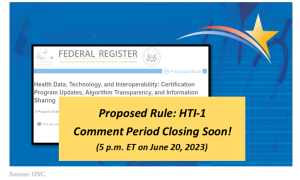A couple of years ago, we blogged about the 170.315(b)(10) “Electronic Health Information (EHI) Export” criterion of the proposed ONC rule based on the 21st Century Cures Act. At that time, the deadline seemed far away, with a 36-month phase-in period. The ONC even offered an interim certification for (b)(10) that only required export of United States Core Data for Interoperability (USCDIv1). Well fast-forward two plus years and the deadline will be here before you know it:

Key EHI Export Deadlines
So, the 170.315 (b)(10) EHI Export certification deadline is December 31, 2023. But a more immediate deadline concerns Information Blocking (see graphic, above). EHR vendors (and their customers) need to be able to export all “EHI” by October 6 of this year (less than three months from the publication of this blog)!
Understanding Electronic Health Information (EHI)
And what is “EHI”? Basically, EHI is the old HIPAA definition of PHI (Protected Health Information) minus psychotherapy notes and information potentially subject to a lawsuit. As you can see above (“Paper portion of DRS”), any PHI that’s not stored electronically may also be excluded. What is the “Defined Record Set” (DRS)? DRS includes:
- Medical records and billing records about individuals;
- Enrollment, payment, claims adjudication, and case or medical management record systems maintained by or for a health plan;
- Other records used, in whole or in part, to make decisions about individuals.
EHI Export Format Requirements
ONC requires that EHI be exported in an electronic, “machine-readable” format but it doesn’t require a particular format, merely that documentation describing the format “must be made available through a publicly accessible hyperlink”. The two common formats that seem relevant are Consolidated-Clinical Document Architecture (C-CDA) and FHIR®. ONC doesn’t require either one and even mentions .CSV files as an acceptable option.
Why DHIT Recommends FHIR for EHI Export
Dynamic Health IT (DHIT) cautions against using a proprietary format and falling into the trap that many EHR vendors experienced when they offered a proprietary API to satisfy the initial 2015 Edition certification. When the Cures Act was finalized, these vendors had to scramble and purchase or develop a FHIR r4 API. DHIT recommends FHIR for both 170.315(b)(10) and Information Blocking, for these reasons:
- FHIR is the “go-forward” standard for health information exchange and it is rapidly growing in adoption and new use cases.
- FHIR is designed for extensibility and even though FHIR r4 (the latest production version endorsed by ONC) does not offer Resources for all types of EHI, it does offer the general-purpose DocumentReference resource.
A DocumentReference resource can include any of the following:
- CDA documents in FHIR systems
- FHIR documents stored elsewhere (i.e., registry/repository following the XDS model)
- PDF documents, Scanned Paper, and digital records of faxes
- Clinical Notes in various forms
- Image files (e.g., JPEG, GIF, TIFF)
- Non-Standard formats (e.g., WORD)
- Other kinds of documents, such as records of prescriptions or immunizations
DHIT’s Dynamic FHIR API Solution
As you can see, the DocumentReference resource is a powerful vehicle for exporting virtually any kind of EHI. DHIT’s Dynamic FHIR API supports custom DocumentReference resources and can not only help you meet the looming Information Blocking deadline for Electronic Health Information (EHI), but it is also certified for 170.315(g)(7,9) and now (g)(10) Bulk FHIR (Flat FHIR).
At DHIT, we are eager to be your strategic partner for ONC requirements. Our expert consulting and bolt-on modules have paved the way for many successful EHR vendor certifications. Please contact us for additional information, sales@dynamichealthit.com.




